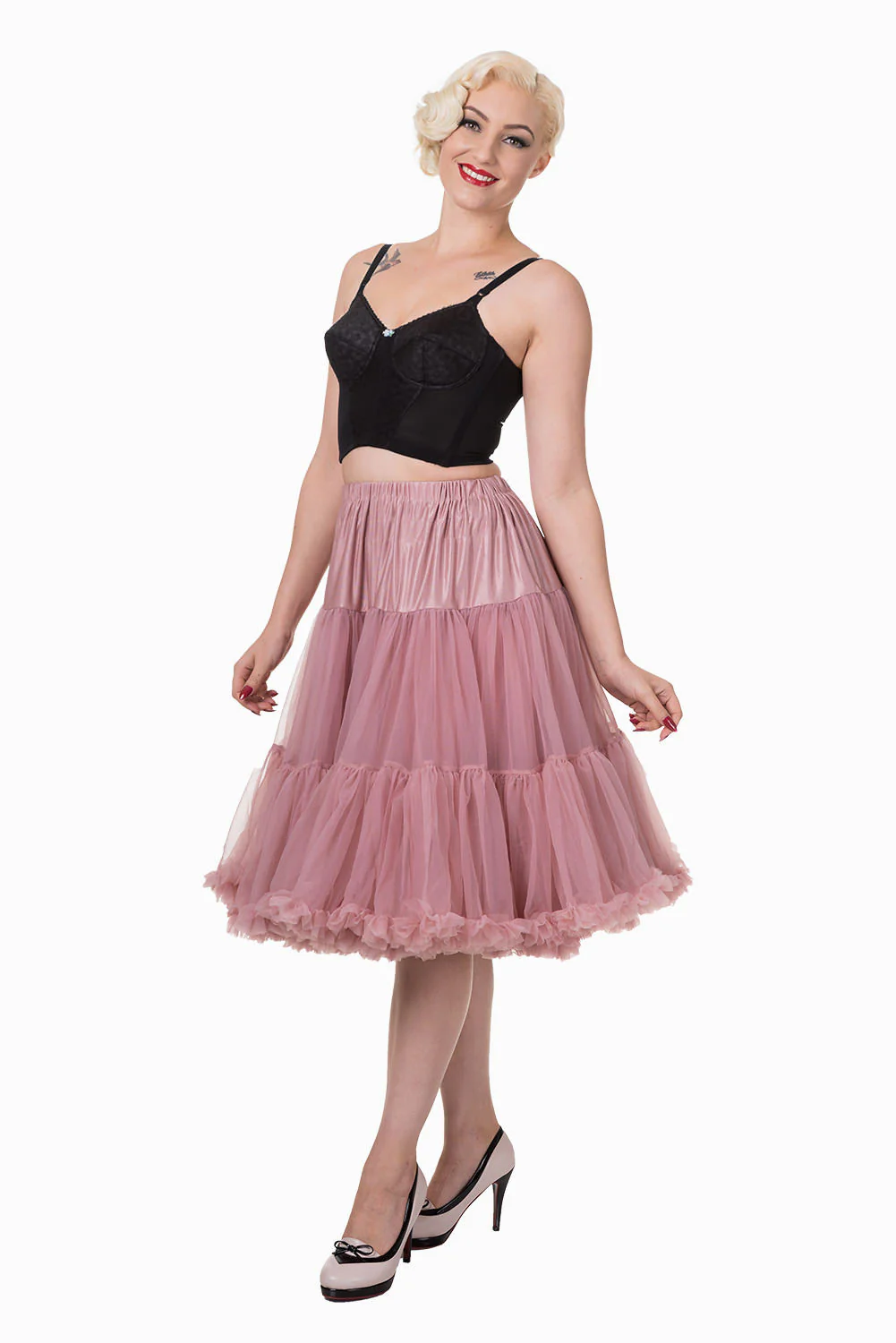
How to Choose the Best Petticoat for Your Outfit
Anna HofmanShare
When it comes to creating the perfect vintage-inspired look, the right petticoat can make all the difference. Whether you're aiming for a subtle lift or a dramatic flair, choosing the right petticoat involves understanding different styles, materials, and how they complement various outfits.
Types of Petticoats
A-Line Petticoats
- Description: A-line petticoats flare out gently from the waist to the hem, creating a subtle, natural shape.
- Best For: A-line skirts, tea-length dresses, and styles that require a moderate lift.
Full Circle Petticoats
- Description: These petticoats are designed to provide maximum volume and flare, creating a dramatic, full-circle effect.
- Best For: 1950s swing dresses, ballroom gowns, and any outfit that requires a significant amount of volume.
Layered Petticoats
- Description: Layered petticoats consist of multiple tiers of fabric, providing both volume and structure.
- Best For: Dresses and skirts that need a lot of lift and shape, particularly those with heavier fabrics.
Crinoline Petticoats
- Description: Crinoline petticoats are stiffened with materials like horsehair or hooping to create a structured, voluminous look.
- Best For: Formal gowns, historical re-enactment costumes, and outfits that require a rigid shape.
Tulle Petticoats
- Description: Made from lightweight tulle, these petticoats offer a delicate, airy lift.
- Best For: Light, flowy dresses, bridal wear, and outfits that require a soft silhouette.
Best Materials For Petticoats
Choosing the Right Material
Cotton Petticoats
- Benefits: Breathable, comfortable, and suitable for everyday wear.
- Best For: Casual vintage dresses and warm-weather outfits.
Nylon Petticoats
- Benefits: Lightweight, adds volume without bulk, and often more affordable.
- Best For: Party dresses, costumes, and formal occasions.
Tulle Petticoats
- Benefits: Soft, airy, and offers a delicate lift.
- Best For: Bridal wear, evening gowns, and lightweight dresses.
Organza Petticoats
- Benefits: Stiffer than tulle, providing more structure while still being lightweight.
- Best For: Dresses that need a moderate to significant lift with a bit of stiffness.
Matching Petticoats with Different Outfits
Vintage Dresses
- 1950s Swing Dress: Choose a full circle or layered petticoat to achieve the iconic full-skirt look.
- A-Line Vintage Dress: Choose an A-line petticoat for a subtle lift that enhances the natural shape.
Modern Outfits
- Evening Gowns: A tulle or organza petticoat can add the right amount of lift without overpowering the dress.
- Casual Dresses: A light cotton or tulle petticoat can provide a gentle flare for a playful, everyday look.
Children’s Clothing
- Girls’ Party Dresses: Choose a lightweight tulle or nylon petticoat to add volume without adding bulk or discomfort.
- Costumes: Crinoline petticoats can provide the dramatic effect needed for costumes and themed events.
Measuring for the Perfect Fit
Waist Measurement
- Ensure the petticoat fits comfortably at the waist. Measure your waist at the narrowest point and choose a petticoat with an adjustable waistband for the best fit.
Length Measurement
- Measure from your waist to the desired hemline. The petticoat should be slightly shorter than your dress or skirt to avoid peeking out.
How To Get a Fuller Skirt - Go Big!
Wearing multiple petticoats to achieve a bigger skirt can be a fun and effective way to create a dramatic and voluminous look, especially for vintage-inspired styles or formal occasions. Here are some tips and considerations for layering multiple petticoats:
1. Choose Complementary Styles:
-
Different Lengths: Layer petticoats of varying lengths to create a tiered effect, with shorter petticoats closer to the body and longer ones on top. This adds dimension and visual interest to the skirt.
-
Varying Volume: Mix petticoats with different levels of volume to achieve the desired fullness. For example, pair a lightweight tulle petticoat with a more structured crinoline or hoop petticoat for added lift and shape.
2. Consider the Fabrics:
-
Texture Contrast: Experiment with different fabrics to create texture contrast and visual appeal. For example, layering a smooth satin petticoat under a fluffy tulle petticoat can add depth to the skirt.
-
Transparency: Keep in mind that sheer or transparent fabrics may reveal the layers underneath, so choose petticoats with opaque linings or wear a slip underneath if necessary.
3. Ensure Comfort and Mobility:
-
Adjustable Waistbands: Choose petticoats with adjustable waistbands or elasticized waistbands to ensure a comfortable fit, especially when layering multiple petticoats.
-
Range of Motion: Consider how multiple layers may affect your range of motion, especially if you'll be walking, sitting, or dancing. Test out the layers beforehand to ensure you can move comfortably.
4. Pay Attention to Proportions:
-
Balance: Keep proportions in mind when layering multiple petticoats. If you're petite or have a smaller frame, opt for narrower or less voluminous petticoats to avoid overwhelming your silhouette.
-
Skirt Length: Ensure that the length of the skirt accommodates the additional volume from the multiple petticoats. You may need to adjust the hemline or choose a skirt with extra length to accommodate the fullness.
5. Experiment and Have Fun:
-
Mix and Match: Don't be afraid to experiment with different combinations of petticoats to achieve the desired look. Mix and match colours, lengths, and styles to create a unique and personalized ensemble.
-
Accessorize: Complete your look with accessories that complement the voluminous skirt, such as a fitted waist belt, statement jewellery, or a coordinating handbag.